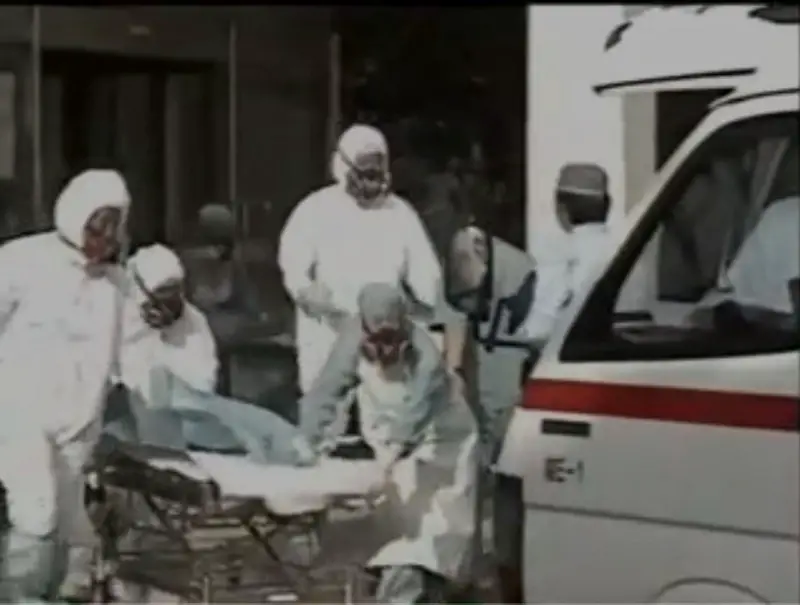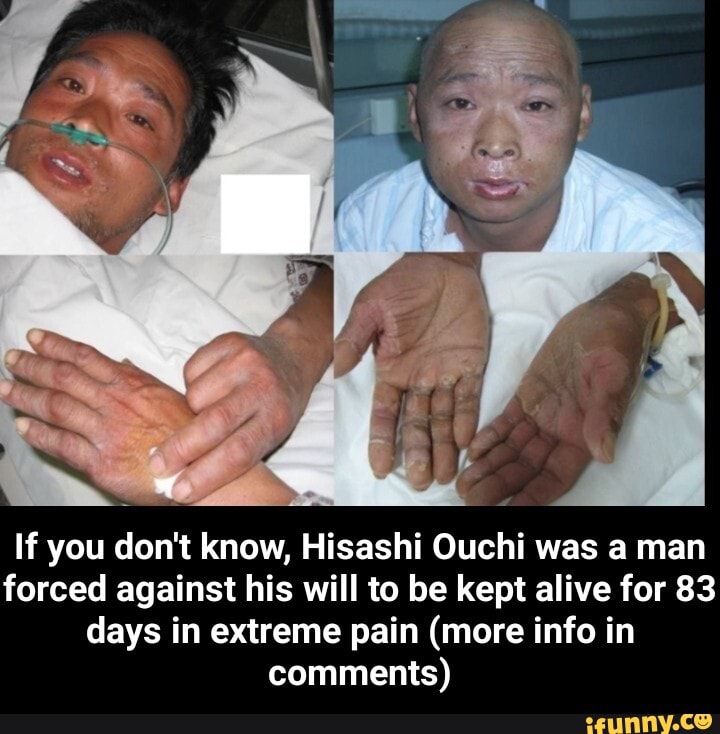Hisashi Ouchi Hospital Pictures have become a crucial element in understanding the medical journey and treatment of Hisashi Ouchi, one of the most notable victims of the 1999 Tokaimura nuclear accident. These images provide insight into the advanced medical care provided to him during his prolonged hospitalization. In this article, we will delve into the details surrounding Hisashi Ouchi's hospital stay, the significance of these pictures, and their role in nuclear safety awareness.
Hisashi Ouchi's tragic story serves as a reminder of the dangers of nuclear accidents and the critical importance of safety protocols. His hospitalization at University of Tokyo Hospital became a focal point for global attention, as medical professionals worked tirelessly to save his life. The pictures taken during this period have since become a symbol of resilience and the dedication of medical teams in handling extreme cases.
Through this article, we aim to explore the background of Hisashi Ouchi, his hospital experience, and the impact of the images captured during his treatment. By understanding the broader context, we hope to shed light on the significance of these hospital pictures and their role in educating the public about nuclear safety and medical advancements.
Read also:Prmovies Your Ultimate Destination For Cinematic Excellence
Table of Contents
- Biography of Hisashi Ouchi
- Overview of Hisashi Ouchi's Hospital Stay
- Significance of Hisashi Ouchi Hospital Pictures
- Medical Care Provided to Hisashi Ouchi
- Details of the Tokaimura Nuclear Accident
- Impact on Public Awareness
- Media Coverage and Public Reaction
- Lessons Learned from the Incident
- Current Status of Nuclear Safety Measures
- Conclusion and Call to Action
Biography of Hisashi Ouchi
Early Life and Career
Hisashi Ouchi was born on June 26, 1968, in Japan. Before the tragic accident, he worked as an operator at the JCO nuclear fuel processing plant in Tokaimura, Ibaraki Prefecture. His career in the nuclear industry began with a strong commitment to safety and efficiency, making his untimely fate even more poignant.
Data and Biodata
| Name | Hisashi Ouchi |
|---|---|
| Birth Date | June 26, 1968 |
| Place of Birth | Japan |
| Occupation | Nuclear Plant Operator |
| Accident Date | September 30, 1999 |
| Hospital | University of Tokyo Hospital |
Overview of Hisashi Ouchi's Hospital Stay
After the criticality accident at the JCO plant, Hisashi Ouchi was rushed to University of Tokyo Hospital, where he spent 83 days under intensive care. The hospital became the epicenter of global attention, as medical teams battled against the clock to save his life. The pictures taken during this time captured the gravity of the situation and the efforts of the medical staff.
Significance of Hisashi Ouchi Hospital Pictures
Visual Documentation of Medical Care
Hisashi Ouchi hospital pictures serve as a visual documentation of the medical care he received. These images highlight the extensive measures taken by doctors and nurses to treat severe radiation exposure. The photographs not only depict the medical equipment used but also the dedication of the medical team.
Raising Awareness
These pictures have played a significant role in raising awareness about the dangers of nuclear accidents. By showcasing the harsh realities of radiation exposure, they have contributed to global discussions on nuclear safety and the importance of stringent protocols.
Medical Care Provided to Hisashi Ouchi
Hisashi Ouchi's treatment involved cutting-edge medical techniques and innovative procedures. The medical team employed skin grafts, blood transfusions, and other advanced methods to mitigate the effects of radiation poisoning. These efforts were documented in the hospital pictures, providing a glimpse into the complexities of his care.
Details of the Tokaimura Nuclear Accident
Cause and Effects
The Tokaimura nuclear accident occurred on September 30, 1999, due to improper mixing of uranium in a precipitation tank. This criticality accident exposed Hisashi Ouchi and two other workers to lethal doses of radiation. The incident highlighted the need for improved safety measures in nuclear facilities worldwide.
Read also:Freezenova Unblocked Your Ultimate Guide To Gaming Without Restrictions
Global Response
The accident prompted an international response, with experts from various countries offering assistance and advice. The aftermath of the incident led to stricter regulations and enhanced safety training for nuclear plant employees.
Impact on Public Awareness
Hisashi Ouchi hospital pictures have had a profound impact on public awareness regarding nuclear safety. They have served as a visual reminder of the potential consequences of nuclear accidents and the importance of prevention. These images have been used in educational materials and advocacy campaigns to promote safer practices in the nuclear industry.
Media Coverage and Public Reaction
Global Attention
The media extensively covered Hisashi Ouchi's hospital stay, with reporters from around the world flocking to Japan for updates. The hospital pictures became a focal point of this coverage, capturing the attention of millions and sparking conversations about nuclear safety.
Public Reaction
The public reaction to Hisashi Ouchi's story was one of sympathy and concern. People worldwide were moved by the images of his hospitalization and the efforts of the medical team. This reaction underscored the need for greater transparency and accountability in the nuclear industry.
Lessons Learned from the Incident
Improved Safety Protocols
One of the key lessons learned from the Tokaimura accident was the necessity of improved safety protocols. Subsequent investigations led to the implementation of stricter regulations and enhanced training programs for nuclear plant workers.
Advancements in Medical Treatment
The treatment of Hisashi Ouchi also highlighted advancements in medical technology and procedures. The knowledge gained from his case has contributed to the development of new techniques for treating radiation exposure.
Current Status of Nuclear Safety Measures
In the years following the Tokaimura accident, significant strides have been made in nuclear safety. Countries around the world have adopted stricter regulations and invested in cutting-edge technologies to prevent similar incidents. The hospital pictures of Hisashi Ouchi continue to serve as a reminder of the importance of these measures.
Conclusion and Call to Action
Hisashi Ouchi hospital pictures provide a powerful visual narrative of the medical response to a catastrophic nuclear accident. They highlight the dedication of medical professionals and the need for stringent safety protocols in the nuclear industry. As we continue to learn from this tragic event, it is crucial to remain vigilant in our pursuit of safer nuclear practices.
We invite you to share your thoughts and insights in the comments section below. By engaging in discussions about nuclear safety and medical advancements, we can contribute to a safer and more informed future. Additionally, we encourage you to explore other articles on our site for further information on related topics.
References:
- World Nuclear Association. (2023). Nuclear Safety. Retrieved from https://www.world-nuclear.org
- International Atomic Energy Agency. (2022). Lessons Learned from Nuclear Accidents. Retrieved from https://www.iaea.org
- University of Tokyo Hospital. (2023). Case Studies. Retrieved from https://www.u-tokyo.ac.jp


